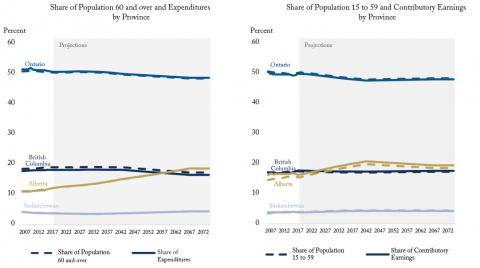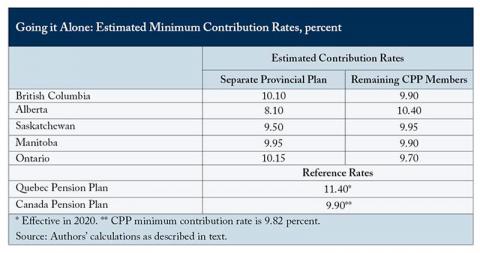From: Alexandre Laurin and Farah Omran
To: Provincial Ministers of Finance
Date: November 25, 2019
Re: Opting out of the Canada Pension Plan
Alberta is studying opting out the Canada Pension Plan, and creating its own equivalent Alberta Pension Plan, much like the Quebec Pension Plan. The attraction of an APP, or theoretically any separate provincial plan, is presumably a function of its ability to provide CPP-like benefits at less cost. Here is a look of what contributions would look like for each province, west of Quebec, if each were to create its own replacement for the CPP.
The contribution rate in a potential separate provincial pension plan would depend critically on the future path of pension benefits and contributory earnings (on which contributions are paid). Each province's share of overall CPP benefits is closely linked to its own share of the CPP population aged 60 and over, and its share of overall CPP contributory earnings is closely linked to its share of the 15-to-59 year-old population. Based on this relationship, we use Statistics Canada’s population projections to project future provincial contributory earnings and benefits based on the Chief Actuary’s latest projections (see Figure).
Source: Authors’ calculations; historical CPP data and population projections. Manitoba not shown here because of space constraints.
To estimate the contribution rate, we apply the same general rule as the Chief Actuary employs for the CPP; i.e., the rate that would result in the projected asset/expenditure ratio of the plan being the same in the 10th and 60th years of the projection horizon.
We also need the value of assets a separate provincial plan would obtain at the outset from the CPP Investment Board. Among the many possibilities resulting from negotiations, here we assume that the provincial share of the CPPIB assets would correspond to its average share of overall CPP contributions since 1981.
We use Statistics Canada’s medium-growth (M3) population projections by province from 2018 to 2043 – the entire period of available data at the provincial level. Since we need projections to extend out to 2075, we use the projected growth for the Canadian population as a whole as a guide (which is available up to 2068) and further assume that each province's age-related population shares slowly converge to Canada’s values by 2068.
Provinces with disproportionately more current and future contributors, and like Alberta also contributing more per contributor on average, may expect a lower cost of providing CPP-like benefits. On the flipside, a disproportionately higher projected growth of beneficiaries, also like in Alberta, increases the cost of providing CPP-like benefits. The table shows the estimated contribution rates for each potential separate provincial plan providing CPP-like benefits, and the flipside new minimum contribution rates for the remaining eight provinces in the CPP.
In a country with free mobility of people, however, population projections can shift quickly, and regional cost sharing provides greater stability of contributions, and insurance against economic and demographic shocks. Quebec, which opted out of the CPP at inception, is a case in point, now dealing on its own with an unexpected older population by hiking contributions.
Alexandre Laurin is Director of Research and Farah Omran is a policy analyst at the C.D. Howe Institute.
To send a comment or leave feedback, email us at blog@cdhowe.org.
The views expressed here are those of the author. The C.D. Howe Institute does not take corporate positions on policy matters.







